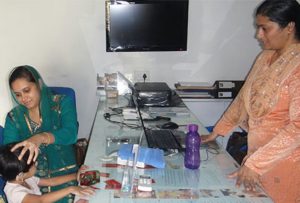“When and How to fit hearing aids in a child” – this is by far one of the most challenging and difficult decisions for an ENT specialist.
Providing amplification for infants and children is undoubtedly a complex endeavor.
- Certain fitting features are unique to the child, hence providing an adequate fit is far more challenging than in adults.
- Expertise and experience are crucial inorder to achieve the perfect fit.
- Sensitization of parents and care givers prior to starting the fitting process is critical as results are very slow to come by.
- Callousness on the part of the clinician or parent unfortunately affects the child through his lifetime. The responsibility to give a correct fit is hence even more.
Some of the problems faced in child hearing aid fittings are:
- Small Ear Canal.
- Difficulty in cleaning the ear canal of debris like wax.
- Inability to record a consistent repose to pure tones [Pure tone Audiogram].
- Difficulty to perform a reliable free field test and elicit results, to select appropriate amplification device.
- Predominant reliance on objective hearing test which are only approximate representation of hearing loss.
- Lack of appropriate feedback to auditory stimulus. [Response to amplified sounds].
Shravan was the first to start early detection and intervention in children at Kochi (Kerala, India). We have formulated our protocol entirely backed by our practical ground experiences.

Our Present protocol for Child fit:
The first step is evaluation by the ENT specialist. It includes the most delicate and important activity of cleaning both the ear canals. At our centers, we prefer the ENT specialist to take the ear impression, since a good quality ear impression goes a long way in achieving a good fit.
The Audiologist uses a combination of test including the Threshold BERA study as a guide to quantify the hearing loss. Initial fitting is purely based on the findings of the objective tests. Further readjustment / programming is carried out based on the actual subjective response of the child.
It has to be kept foremost in mind that reliable-meaning-response to sounds in a ‘first-fit pre-lingual’ child is usually seen only after about 3 months of hearing aid fitting. Only after reliable response to meaningful sound is observed do we use these indicators to achieve the final correct fit. This is a challenging, slow and time consuming process.
All of us aim to achieve optimal amplification. The fitting process resulting in insufficient amplification will hinder adequate speech development. Over amplification may result in further hearing loss, intolerance and rejection of hearing aid by the child. Hence at Shravan, we prefer under amplification to over amplification.
Active participation of the parents is necessary during the fitting session. Parents will be instructed as to how they can utilise the ‘Ling’ sounds to screen the frequency response with hearing aids. Hence they have to play an active role in helping the audiologist in this process, to provide optimal amplification to the child.
Kindly remember, the hearing aid fitting for paediatric population is an ongoing processes, multiple visits post fitting is a routine to achieve optimal amplification. Also, Auditory training / Auditory verbal therapy is mandatory to help the children develop adequate speech and language skills trough listening.
